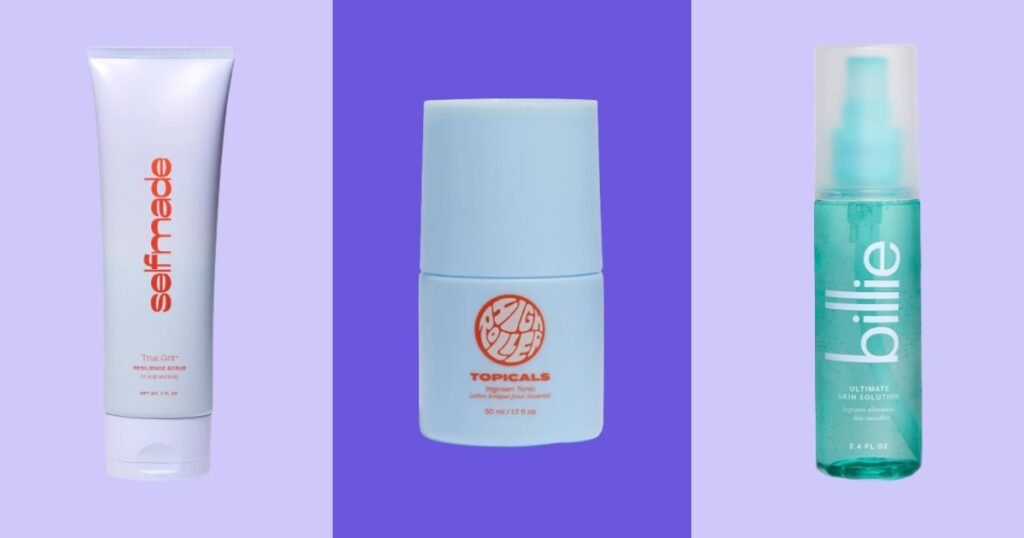Your Complete Guide to Treating and Preventing Ingrown Hairs
Dealing with ingrown hairs after shaving, waxing, or epilating can be both frustrating and uncomfortable. These pesky hairs occur when hair curls back into the skin instead of growing outward, often leading to itching, redness, and even pain. Luckily, ingrown hairs, also known as razor bumps, can be effectively treated at home. However, patience is crucial; expect gradual improvement rather than instant relief.
Understanding Ingrown Hairs
What Causes Ingrown Hairs?
- Hair Removal Method: While shaving is commonly associated with ingrown hairs, methods like waxing and plucking are often more problematic. These methods remove hair from the follicle, increasing the likelihood that new hair will not grow correctly.
- Hair Type: Curly, thick hair is more prone to curling back into the skin, causing ingrown hairs.
- Skin Condition: If the skin isn’t healthy, new hair struggles to grow properly, leading to the risk of ingrown hairs.
Common Symptoms
- Red or inflamed bumps on the skin
- Itching or pain in the affected area
- Pus-filled lesions in more severe cases
Effective Home Treatments
Step 1: Calm the Irritation
Engaging with irritated skin is crucial before direct treatment. Use first-aid ointments and cold compresses to reduce swelling and pain.
Step 2: Spot Treatment
Use targeted acne products containing benzoyl peroxide or salicylic acid. These act as chemical exfoliants, helping to remove dead skin around the ingrown hair, allowing it to surface.
Recommended Treatments
-
First-Aid Ointment:
- Neosporin Original Antibiotic Ointment
- Benefits: Helps heal skin, prevent infection, and reduces scarring.
- Usage: Apply 1-3 times daily.
- Neosporin Original Antibiotic Ointment
-
Anti-Itch Solution:
- Cortizone 10 Maximum Strength Anti-Itch Cream
- Benefits: Reduces inflammation and soothes irritation.
- Usage: Apply up to four times daily.
- Cortizone 10 Maximum Strength Anti-Itch Cream
-
Roll-On Treatment:
- Topicals High Roller Ingrown Hair Tonic
- Benefits: Contains salicylic acid and zinc to minimize irritation.
- Usage: Apply directly to affected areas.
- Topicals High Roller Ingrown Hair Tonic
- Overnight Treatment:
- Mario Badescu Drying Lotion
- Benefits: Reduces redness while you sleep.
- Usage: Apply with a cotton swab before bed.
- Mario Badescu Drying Lotion
Prevention Tips
Skincare Routine
Before and after hair removal, focus on maintaining healthy skin.
- Cleansing: Choose face and body washes with salicylic or glycolic acid to minimize bacteria.
- Exfoliating: Both chemical and physical exfoliants help clear dead skin cells.
- Moisturizing: Keep skin hydrated with non-comedogenic moisturizers post-hair removal.
Recommended Preventative Products
-
Best Body Wash:
- Cetaphil Acne Relief Body Wash
- Benefits: Gentle yet effective at reducing bacteria, leaving skin soft.
- Cetaphil Acne Relief Body Wash
-
Best Face Wash:
- Neutrogena Oil-Free Acne Wash
- Benefits: Helps unclog pores and eliminate excess oil.
- Neutrogena Oil-Free Acne Wash
- Best Exfoliating Spray:
- Billie Ultimate Skin Solution
- Benefits: Quick-drying spray with salicylic acid.
- Billie Ultimate Skin Solution
Shaving Technique
To minimize the risk of ingrown hairs during shaving:
- Shave After a Shower: Warm water softens the skin and hair.
- Use Quality Razors: Always use a sharp blade and consider single-blade razors.
- Short Strokes: Shave in the direction of hair growth to reduce the risk of hair curling back into the skin.
Frequently Asked Questions
What is an ingrown hair?
An ingrown hair is when hair curls back or grows sideways into the skin, causing inflammation.
How do you get ingrown hair?
While they commonly occur after shaving, ingrown hairs can also result from waxing, plucking, or epilating due to hair being removed from the follicle.
Where can you get ingrown hairs?
Ingrown hairs can develop in any hair-bearing area, particularly where hair is coarse, such as the face, neck, underarms, and legs.
Who is most prone to ingrown hairs?
Individuals with curly or coarse hair types are at a higher risk.
Should you pop ingrown hairs?
Avoid picking at ingrown hairs as it can lead to infections and prolong healing.
When should you see a doctor?
If ingrown hairs become painful, show signs of infection, or if they recur frequently, consult a dermatologist.
Conclusion
Ingrown hairs can be an annoying issue, but with effective home treatments and preventative measures, they can be managed successfully. By understanding and applying these methods, you can keep your skin healthy while enjoying smooth hair-free areas.
For more information and expert recommendations, consider exploring additional resources on ingrown hair treatment here and here.


